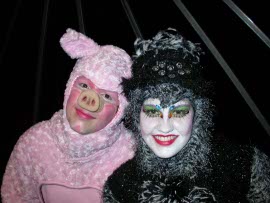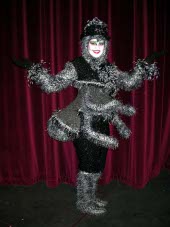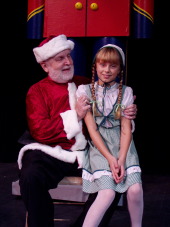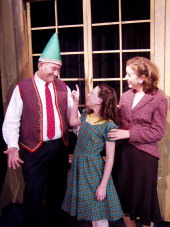 If I counted correctly, St. Ambrose University's Charlotte's Web and Quad City Music Guild's Miracle on 34th Street featured a grand total of five dozen actors between them. Yet the true stars of both musicals weren't among those individuals; despite boasting an excellent Wilbur the Pig in Ryan Westwood, Charlotte's Web was primarily a triumph for set designer Kristofer Eitrheim, and Miracle belonged to no one so much as scenic artist Bob Williams. Eitrheim's and Williams' contributions were dazzling, and my only regret in raving about their work now is that it's too late for new audiences to admire it. (Both presentations ran only one weekend and closed on December 2.)
If I counted correctly, St. Ambrose University's Charlotte's Web and Quad City Music Guild's Miracle on 34th Street featured a grand total of five dozen actors between them. Yet the true stars of both musicals weren't among those individuals; despite boasting an excellent Wilbur the Pig in Ryan Westwood, Charlotte's Web was primarily a triumph for set designer Kristofer Eitrheim, and Miracle belonged to no one so much as scenic artist Bob Williams. Eitrheim's and Williams' contributions were dazzling, and my only regret in raving about their work now is that it's too late for new audiences to admire it. (Both presentations ran only one weekend and closed on December 2.)
For those who saw director Madeline Dudziak's Charlotte's Web, though, it's hard to imagine forgetting it. Not because the production was so spectacular (on Saturday afternoon, at least, it wasn't), but because Eitrheim's designs had a sprawling, storybook grandeur that took your breath away. Aided by exquisitely detailed backdrops that, somehow, were simultaneously broad and very specific, the functional sets featured just the right amount of children's-show stylization, and I'm not sure that any amount of superlatives can adequately describe Charlotte's web itself. A towering unit that stood (I'm estimating) 15 feet by 15 feet, the sturdy set piece found Charlotte (Emily Christiansen) routinely climbing on its silken strands - the production gave the actress quite the workout - and had the effect of making this spider appear genuinely smaller than her barnyard friends; magical thinking like that makes you want to applaud a scenic designer.
 Amazingly, though, the magic didn't end there, as the words that Charlotte famously spins into her web were revealed through tiny lights within the web; the gradual illumination of "some pig," "humble," and "radiant" instilled the kind of delirious joy you felt watching Dorothy walk out of black-and-white Kansas and into Munchkinland. (Eitrheim also served as Charlotte's Web's lighting designer.) The cast took a group curtain call at the play's end, but it felt a tad empty without Eitrheim - and the extraordinary costume designer Dianne Dye - there, too.
Amazingly, though, the magic didn't end there, as the words that Charlotte famously spins into her web were revealed through tiny lights within the web; the gradual illumination of "some pig," "humble," and "radiant" instilled the kind of delirious joy you felt watching Dorothy walk out of black-and-white Kansas and into Munchkinland. (Eitrheim also served as Charlotte's Web's lighting designer.) The cast took a group curtain call at the play's end, but it felt a tad empty without Eitrheim - and the extraordinary costume designer Dianne Dye - there, too.
It would take loads of personality for a performer not to be overshadowed by Charlotte's Web's design, and thankfully, Ryan Westwood refused to blend into the scenery. His Wilbur was a dream of a children's-show lead - funny, energetic, and physically and verbally inventive throughout. (Westwood's lines were familiar from E.B. White; his readings came from a happily inspired universe all his own.) And a few actors came close to matching Westwood's dynamism: Emily Kurash and Abby Van Gerpen provided wonderful fun as a sheep and her lamb, and Jessica Denney and Adam Burnham played Fern and Avery with appropriate youthful vigor.
Most of the others, however, appeared content to let Dye's costumes do their work for them, emerging as little more than blandly serviceable accessories, and the show's needlessly complex musical score - through well-played by the on-stage band - certainly didn't do the performers any favors. (For those wondering, this was a different Charlotte's Web adaptation from the one performed at the Circa '21 Dinner Playhouse this past spring.) Barring the catchy "Welcome to the Zuckermans' Barn," the songs featured cues and lyrics so knotty that they were barely coherent; when Fern and Avery's time-killing "Don't!" number was followed by a turgid Charlotte ballad, the show, for several minutes, seemed to lose the audience completely. Charlotte's Web was oftentimes a chore to listen to; thank goodness there was always something enjoyable to look at.
 But the songs in St. Ambrose's family musical were divine compared to the atrocious ones heard in Music Guild's Miracle on 34th Street. I'm kind of thrilled that the show has already closed, as I don't have to exert energy on convincing you to avoid it, but this had to have been one of the least inspired stage adaptations of a beloved movie I've ever sat through. With music and lyrics by Douglas M. Smith and Vernon L. Stefanic, not only were the songs either generically sentimental or just plain loopy - the evil Dr. Sawyer's "Wrong" number, performed here under Margaret Hamilton-esque, emerald-green lighting, was a particular nightmare - but the damned things kept getting reprised, and Smith's and Stefanic's tuneless and musically convoluted offerings were noxious enough the first time around. (At Thursday's opening-night performance, soloists frequently seemed to enter the score at the wrong time, but for the life of me, I couldn't tell when the right time might've been.)
But the songs in St. Ambrose's family musical were divine compared to the atrocious ones heard in Music Guild's Miracle on 34th Street. I'm kind of thrilled that the show has already closed, as I don't have to exert energy on convincing you to avoid it, but this had to have been one of the least inspired stage adaptations of a beloved movie I've ever sat through. With music and lyrics by Douglas M. Smith and Vernon L. Stefanic, not only were the songs either generically sentimental or just plain loopy - the evil Dr. Sawyer's "Wrong" number, performed here under Margaret Hamilton-esque, emerald-green lighting, was a particular nightmare - but the damned things kept getting reprised, and Smith's and Stefanic's tuneless and musically convoluted offerings were noxious enough the first time around. (At Thursday's opening-night performance, soloists frequently seemed to enter the score at the wrong time, but for the life of me, I couldn't tell when the right time might've been.)
The show's book, sadly, was every bit as weak - without prior knowledge of the film, Nathan Bates' Fred, Jennifer Sondergoth's Doris, and Mark Holmes' Sawyer, among others, made no sense at all - and director Tom Morrow's staging routinely found actors, in conversation, turning and reciting lines directly to the audience, as if participating in a spelling bee. The only true moments of levity came from a few supporting performers: the vivacious Abbey Donohoe gave the production's standout portrayal as the judge's assistant, and Heidi Pedersen, Susie Carsell-Schaechter, and fourth-grader Ally Zahringer - speaking and singing in Dutch - each had impressive moments. (Gary Clark's Kris Kringle was nicely understated, but the actor was also stuck with most of the show's clunkier songs.)
 Thank heavens, then, for Bob Williams' designs. He fashioned topnotch living-room and courtroom sets, but his coup de grâce came with Macy's toy department, which any audience member, regardless of age, would have been thrilled to play in, particularly if they were allowed to climb atop the enormous wooden soldiers that bookended Santa's workshop. Music Guild's latest may have been notably lacking in miracles, but Williams, at least, provided more than his share.
Thank heavens, then, for Bob Williams' designs. He fashioned topnotch living-room and courtroom sets, but his coup de grâce came with Macy's toy department, which any audience member, regardless of age, would have been thrilled to play in, particularly if they were allowed to climb atop the enormous wooden soldiers that bookended Santa's workshop. Music Guild's latest may have been notably lacking in miracles, but Williams, at least, provided more than his share.










